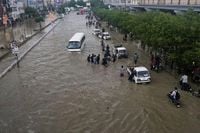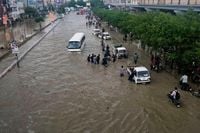Pakistan is once again grappling with the devastating aftermath of extreme monsoon rains, as the country races to recover from flash floods that have killed more than 300 people in the north and northwest regions. On Tuesday, August 19, 2025, officials announced significant progress: damaged roads have been reopened, and 70% of the region’s electricity has been restored. However, the crisis is far from over, with continued rainfall lashing flood-hit areas and thousands still displaced or missing.
According to the Associated Press, Information Minister Attaullah Tarar addressed the press, emphasizing that engineers are working tirelessly to fully restore the electricity system after flooding last week knocked out power across vast swathes of the country. "Most roads have been cleared, facilitating the supply of food and other essential items to flood-affected areas," Tarar reported. This restoration has been a lifeline for communities that were, until recently, cut off by impassable roads and landslides.
The scale of the disaster became clear in Buner, a district in Khyber Pakhtunkhwa province, where a sudden cloudburst on Friday, August 15, claimed at least 280 lives. Prime Minister Shehbaz Sharif responded by ordering authorities to accelerate recovery efforts in the region. The urgency is palpable: search teams, aided by army sniffer dogs, are still combing through debris in Buner, desperately searching for about 150 people who remain missing. Rescue official Mohammad Suhail described the scene as one of the worst since the rains began late last month.
Military involvement has been critical. Army spokesman Lt. Gen. Ahmed Sharif explained that military doctors are treating survivors while engineers work to repair crucial infrastructure. "Troops using helicopters have also delivered food and supplies to remote villages cut off by floods and landslides," Sharif stated. The logistical challenges are immense, with entire communities isolated by water and mud, but the military’s efforts have brought hope to many who felt abandoned.
The human toll continues to mount. The National Disaster Management Authority reported that, since June 26, 2025, monsoon rains have triggered floods that killed more than 700 people nationwide. Over 25,000 people have been evacuated from their homes, forced to seek refuge in makeshift shelters or with relatives in less-affected areas. The trauma of displacement is compounded by the loss of livelihoods, with crops destroyed and livestock swept away by the relentless waters.
Yet, amid the response, there has been public outrage and frustration. Residents of Buner accused authorities of failing to issue timely evacuation warnings. Community elders pointed out that no alerts were broadcast from mosque loudspeakers—a traditional and trusted warning system in remote regions. Officials, for their part, insisted that the cloudburst struck so suddenly that there was simply no time to warn those in harm’s way. This disconnect between local expectations and official explanations has fueled debate about Pakistan’s disaster preparedness and communication strategies.
The crisis has not been confined to the northern provinces. On the same Tuesday, torrential monsoon rains battered Karachi, Pakistan’s southern port city, killing at least 10 people in rain-related incidents and flooding major streets. Local emergency services described scenes of chaos, with people wading through chest-high water on submerged roads. According to reports from the Los Angeles Times, much of Karachi’s road network was underwater within hours of the first showers of the month, paralyzing daily life and disrupting commerce.
Despite repeated government assurances of preparedness, the reality on the ground has told a different story. Year after year, major cities in Pakistan struggle to cope with the annual monsoon deluge, drawing sharp criticism from citizens and urban planners alike. Poor drainage infrastructure, rapid urbanization, and a lack of coordinated emergency response have all contributed to the recurring chaos. As one observer put it, “Despite the government’s claims of preparedness, people could be seen wading through chest-high water in some submerged city roads.”
The monsoon season, which runs from July through September, is both a blessing and a curse for Pakistan. While the rains are vital for agriculture, they also bring the ever-present threat of deadly floods. Authorities have been quick to warn of a possible repeat of the catastrophic 2022 floods, which killed nearly 1,700 people and were widely attributed to climate change. The memory of that disaster, still fresh in the minds of many Pakistanis, has heightened anxiety and put additional pressure on officials to act decisively.
Climate change is increasingly being recognized as a key driver behind the intensifying monsoon patterns. Scientists and environmentalists have pointed out that rising global temperatures are making extreme weather events more frequent and severe. In Pakistan, this translates to heavier rainfall over shorter periods, overwhelming rivers, dams, and urban drainage systems not designed for such extremes. Authorities are now grappling with the urgent need to adapt infrastructure and improve early warning systems to protect vulnerable communities.
Yet, adaptation is easier said than done. Pakistan faces significant economic challenges, with limited resources to invest in large-scale flood defenses or modernize its energy grid. The restoration of 70% of the affected region’s electricity is a testament to the dedication of engineers and workers, but it also highlights the fragility of essential services in the face of natural disasters. As engineers continue their efforts, many residents remain without reliable power, compounding the difficulties of recovery.
Meanwhile, the government’s response is under intense scrutiny. Prime Minister Shehbaz Sharif’s directive to accelerate recovery in Buner is seen as a necessary step, but critics argue that a more comprehensive, long-term approach is needed. This includes not only rebuilding damaged infrastructure but also investing in disaster risk reduction, community education, and climate resilience. The recurring nature of Pakistan’s flood crises suggests that short-term fixes are no longer sufficient.
For those on the ground, the situation remains precarious. Search and rescue operations continue in Buner, where families wait anxiously for news of missing loved ones. In Karachi and other cities, the clean-up has only just begun, with authorities racing against time to restore normalcy before the next downpour. The specter of the 2022 floods looms large, a sobering reminder of what can happen when nature’s fury meets human vulnerability.
As the monsoon season continues, Pakistan’s struggle underscores a broader challenge facing many countries in South Asia: how to balance the life-giving promise of seasonal rains with the ever-growing threat of disaster. The lessons of 2025, hard-earned and heartbreaking, may yet shape a more resilient future—if they are heeded.






